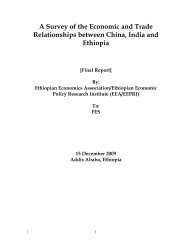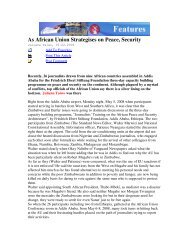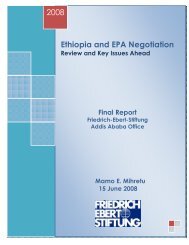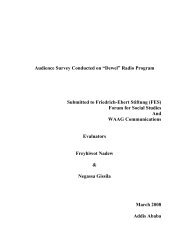external influence in the making of development ... - FES Ethiopia
external influence in the making of development ... - FES Ethiopia
external influence in the making of development ... - FES Ethiopia
Create successful ePaper yourself
Turn your PDF publications into a flip-book with our unique Google optimized e-Paper software.
Introduction<br />
Nations rise and fall. Empires emerge and vanish. Development spreads <strong>in</strong> one part <strong>of</strong><br />
<strong>the</strong> world whereas under<strong>development</strong> persists <strong>in</strong> ano<strong>the</strong>r. Yet, revolutionary changes that<br />
have occurred <strong>in</strong> some parts shift places to o<strong>the</strong>r parts <strong>of</strong> <strong>the</strong> world. The hot spots <strong>of</strong><br />
power change places accord<strong>in</strong>gly.<br />
There are some discernable shared patterns <strong>in</strong> how countries evolve over time. Each<br />
period exhibits, however, unique features and characteristics. The current epoch is<br />
characterized by <strong>in</strong>formation driven economic dynamism as opposed to physical capital,<br />
i.e., <strong>in</strong>formation technology ra<strong>the</strong>r than motor technology drives economic progress.<br />
What uniquely dist<strong>in</strong>guishes current age from past is <strong>the</strong> force <strong>of</strong> globalization that is<br />
unleashed by certa<strong>in</strong> economic forces and new types <strong>of</strong> technologies. Although each<br />
economic period <strong>in</strong> history has its own unique features, <strong>the</strong> current stage is probably most<br />
dist<strong>in</strong>guished <strong>in</strong> <strong>the</strong> sense that what happens <strong>in</strong> one part <strong>of</strong> <strong>the</strong> world affects events <strong>in</strong><br />
different parts <strong>of</strong> <strong>the</strong> world where no one seems to have absolute control over events <strong>in</strong> its<br />
doma<strong>in</strong>. So, this time around, not only <strong>the</strong> nature <strong>of</strong> technology but also <strong>the</strong> conditions<br />
under which human be<strong>in</strong>gs and nations <strong>in</strong>teract with each o<strong>the</strong>r have changed.<br />
As a result, <strong>the</strong> current poor nations are doubly disadvantaged. Those at <strong>the</strong> power end<br />
have <strong>the</strong> lead not only <strong>in</strong> terms <strong>of</strong> resources and technology, but also have powerful<br />
channel at <strong>the</strong>ir disposal to shape and guide global trends to <strong>the</strong>ir advantage. The weak<br />
po<strong>in</strong>ts <strong>of</strong> poor countries are no more restricted to resources and technology but to lack <strong>of</strong><br />
sovereign control over <strong>the</strong>ir <strong>in</strong>ternal matters.<br />
New global <strong>in</strong>itiatives and structures are tak<strong>in</strong>g place at rapid rate driven by both<br />
objective economic forces and deliberate policy actions. These <strong>in</strong> tern are <strong>in</strong>fluenc<strong>in</strong>g<br />
bilateral and multilateral relations. The new forces <strong>of</strong> change that drive <strong>development</strong><br />
cooperation <strong>in</strong>clude <strong>the</strong> drive to establish global free trade system, promote democratic<br />
systems, peace and stability (counterattack, <strong>the</strong>refore, terrorism and religious extremism),<br />
and atta<strong>in</strong> <strong>in</strong>ternational <strong>development</strong> goals and environmental protection. It is not<br />
surpris<strong>in</strong>g, <strong>the</strong>refore, <strong>the</strong> develop<strong>in</strong>g world is engulfed more and more with proposals <strong>of</strong><br />
policy and <strong>in</strong>stitutional ideas/measures than <strong>the</strong> rate <strong>of</strong> technology and resource transfers<br />
it gets. The two types <strong>of</strong> transfers are also <strong>in</strong>creas<strong>in</strong>gly becom<strong>in</strong>g <strong>in</strong>tertw<strong>in</strong>ed. Transfer<br />
<strong>of</strong> resources is mostly conditioned on acceptance and implementation <strong>of</strong> certa<strong>in</strong> policies/<br />
programs (with implications to adoption <strong>of</strong> specific technologies) by <strong>the</strong> recipient<br />
countries. One can assert that <strong>development</strong> aid is be<strong>in</strong>g highly <strong><strong>in</strong>fluence</strong>d by <strong>the</strong><br />
globalization process and as such bears now unique ‘globlateral’ dimension.<br />
To <strong>the</strong> extent that <strong>the</strong>re is some shared patterns on how countries evolve <strong>in</strong> <strong>development</strong>,<br />
some lessons could be drawn from relatively more advanced economies. However,<br />
susta<strong>in</strong>able <strong>development</strong> is likely to occur only if measures are grounded on objective<br />
local conditions and historical traditions that take <strong>in</strong>to account social, cultural and natural<br />
factors. Unfortunately, <strong>the</strong> develop<strong>in</strong>g countries are <strong>in</strong>creas<strong>in</strong>gly loos<strong>in</strong>g capacity to<br />
shape and govern <strong>the</strong>ir own course <strong>of</strong> <strong>development</strong>.<br />
2







